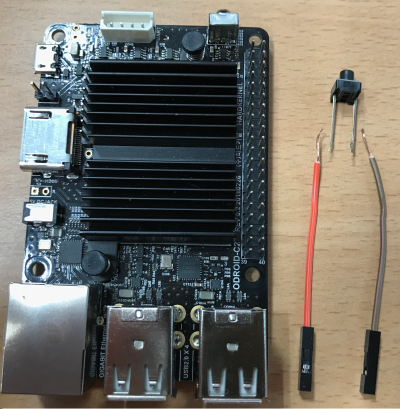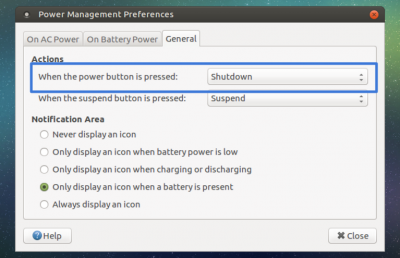This is an old revision of the document!
Table of Contents
Power Off and Wake Up using GPIO Key Button
This section describes how to set up GPIO key button for power off and wake up purpose.
The brief set-up flow is as following.
- Connect a tab button to the pin port you want to use
- Set GPIO number using boot.ini
- Compiling and flash the modified kernel dts : This part is only needed on ANDROID.
1. Hardware Set-Up
First, You need to prepare a tab switch that are connected to two lines.
Red line is for Power Button and another Gray line is for the active level line (Ground or 3.3V Power).
For example, we will use Pin#29 of 40pin expansion connector.
The pin is assigned to GPIOX.BIT0 and its GPIO number is #228.
Connect the red line to Pin#29.
Its default pin pulled status is high and switch active will be Low, so you should connect the gray line of tab switch to Ground (GND), Pin#30.
| Pin Number (Red Line) | GPIO Number | Active Level (Gray Line) |
|---|---|---|
| 29 | GPIO#228 | Active Low (Pin 30) |
Setting boot.ini
You can assign GPIO number with env gpiopower in boot.ini.
# gpio power key : J2 (2x20) Pin#29 , GPIOX.BIT0
setenv gpiopower "228"
...
...
setenv bootargs ${bootargs} gpiopower=${gpiopower}
Setting Power Button Action for Power Off
Ubuntu
When you turn the board off using power button, you need to change power key action pattern.
- Open Power Management Preferences : [System] → [Preferences] → [Hardware] → [Power Management]
- and then Select [General] tab
Android
In case of Android, one short power key event is used for sleep and with long key event, you can handle options of power off/reboot.
With Android Marshmallow v2.4 or higher version, it's available to enter power off sequence using long-pressing (5 sec).
Available Key Numbers
1. J2 - 2×20 pins
| Pin Number | Net Name | GPIO Number | Active Level | Pin Number | Net Name | GPIO Number | Active Level |
|---|---|---|---|---|---|---|---|
| 1 | 3.3V Power | 2 | 5.0V Power | ||||
| 3 | I2CA_SDA | N/A | 4 | 5.0V Power | |||
| 5 | I2CA_SCL | N/A | 6 | Ground | |||
| 7 | GPIOX.BIT21 | GPIO#249 | High → Low | 8 | TXD1 | N/A | |
| 9 | Ground | 10 | RXD1 | N/A | |||
| 11 | GPIOX.BIT19 | GPIO#247 | High → Low | 12 | GPIOX.BIT10 | GPIO#238 | High → Low |
| 13 | GPIOX.BIT11 | GPIO#239 | High → Low | 14 | Ground | ||
| 15 | GPIOX.BIT9 | GPIO#237 | High → Low | 16 | GPIOX.BIT8 | GPIO#236 | High → Low |
| 17 | 3.3V Power | 18 | GPIOX.BIT5 | GPIO#233 | High → Low | ||
| 19 | GPIOX.BIT7 | GPIO#235 | High → Low | 20 | Ground | ||
| 21 | GPIOX.BIT4 | GPIO#232 | High → Low | 22 | GPIOX.BIT3 | GPIO#231 | High → Low |
| 23 | GPIOX.BIT2 | GPIO#230 | High → Low | 24 | GPIOX.BIT1 | GPIO#229 | High → Low |
| 25 | Ground | 26 | GPIOY.BIT14 | GPIO#225 | Low → High | ||
| 27 | I2CB_SDA | N/A | 28 | I2CB_SCL | N/A | ||
| 29 | GPIOX.BIT0 | GPIO#228 | High → Low | 30 | Ground | ||
| 31 | GPIOY.BIT8 | GPIO#219 | High → Low | 32 | GPIOY.BIT13 | GPIO#224 | High → Low |
| 33 | GPIOX.BIT6 | GPIO#234 | Low → High | 34 | Ground | ||
| 35 | GPIOY.BIT3 | GPIO#214 | High → Low | 36 | GPIOY.BIT7 | GPIO#218 | High → Low |
| 37 | ADC.AIN1 | N/A | 38 | 1.8V Power | N/A | ||
| 39 | Ground | 40 | ADC.AIN0 | N/A |
2. J7 - 1×7 pins
| Pin Number | Net Name | GPIO Number | Active Level |
|---|---|---|---|
| 1 | Ground | ||
| 2 | GPIOAO.BIT6 | GPIO#128 | High → Low |
| 3 | P5V0 | 5.0V Power | |
| 4 | GPIOAO.BIT8 | GPIO#130 | High → Low |
| 5 | GPIOAO.BIT10 | GPIO#132 | High → Low |
| 6 | GPIOAO.BIT9 | GPIO#131 | High → Low |
| 7 | GPIOAO.BIT11 | GPIO#133 | High → Low |
3. SW1
| Pin Number | Net Name | GPIO Number | Active Level |
|---|---|---|---|
| 1 | NC | N/A | |
| 2 | GPIOY.BIT5 | GPIO#216 | High → Low |
| 3 | GND | Ground |



